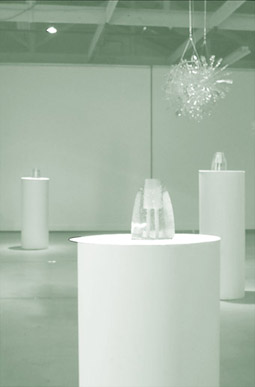Architecture does sound
Douglas Kahn

Nigel Helyer, Caliban's Children (above), Densil Cabrera, Serenade, in Crosstalk (on plinths)
The cross talk of the title no doubt refers to the way sounds from the different pieces ‘bleed’ (ouch!) into one another when placed in close proximity. Often, in exhibitions involving sound, ‘cross’ could apply to the antagonism of competing sounds, but here there is no anger, no claims staked, nobody out of control, no rude interruptions. The installation strategy of Cross Talk is to only include works that are so gentle and unobtrusive that, even as they share the same space, they don’t get in each other’s way. Faced with the alternatives—come up with the money for separate, insulated spaces; alternate the operation of pieces; put them on headphones; or let them battle it out, the most boisterous wins—this is perfectly valid. It is a bit odd, however, given the institutional connection, since architecture at some point conjures up monumentality, the discarded shells of history lashed by weather and baked mercilessly for generations by the sun, the gaudiness of too many expensive magazines and self-congratulatory award ceremonies, you name it, not just quiet little corners more reminiscent of cupboards. Whether all 6 pieces in the show flourish in such toned-down surrounds is a separate question.
Konrad Skirlis’s BuzZAir was the loudest of the bunch, but then again its delicate gritty squeals, windy pulses and the like—what he calls dirty sounds—have been exiled to the outside. Problem was that the buses, cars and aeroplanes were there first and if electricity is to compete with the sounds of the petroleum economy, it needs some juice. A block down the street there was a transformer in ill repair that put up more of a fight. Densil Cabrera’s Serenade was a belated entry into the contest held by the Imperial Academy of St. Petersburg in 1779 to determine the character of vowel sounds and make a device to sound them, so to speak. With the assistance of the glass artist Peter Wright, Cabrera modelled vocal tracts down the centre of rugged glass plugs, upon which listeners rested their ears. It was difficult to determine which vowels were being fluted from the separate pieces, probably because they were reduced to a whisper. The pieces were elegant and the idea a good one, but Christian Gottlieb Kratzenstein already won the contest in the early 1780s. Kratzenstein had an inexplicable aversion to diphthongs; perhaps there is something to explore here.
Floriferous was a beautiful multimedia work by Kirsty Beilharz, who also composed and performed the accompanying piano piece. The piece was a good vehicle for harmonizing obvious talents flowing in several directions, but the material substratum of all the carved frames, garden shots, orientalism, sat awkwardly on the flat little screen, and the music of a high modernist register seemed out of place for a show ostensibly addressing the problematic and possibilities of sound. Likewise, Michaela James’ Overbalancing seemed more concerned with reconciling sound with the artist’s skills as a painter rather than proposing an integrated work in its own right.
The 2 most successful works were by Mark Jones and Nigel Helyer. Jones’ Eine Kleine Licht Musik was certainly the most architectural. Light, projected through 2 rotating multicoloured and mineralised filters, continually traversed across the mouth of a large white ceramic bowl flanked by 2 white vases. Tucked away at the back were sensors that converted the light to raspy little sounds emanating from a speaker placed below the crockery. It was difficult to determine how the light might correlate to the sounds, as the filters overlapped and went in and out of phase with one another, but the overall effect was to give light movement and volume, common attributes of sound, while the sound assumed more of the steady-state feel of light. The piece could have been more architectural still if Vitruvius had been consulted on “sounding vessels in the theatre,” Chapter 5, Book 5, of his Ten Books of Architecture.
Finally, Helyer’s Caliban’s Children comprised a series of what looked like large plexiglas squid suspended from the ceiling, or ornate trumpets, squid trumpets, driven by some circuit-board and speaker action where the mouthpiece should be. The title refers to the sound sensitive Caliban and his “isle full of noises” from Shakespeare’s Tempest. The isle, in this case, is Australia and the children are its inhabitants, who not only tread upon the indigenous and colonial politics on the “un-inhabited island” of the play, but also tread upon sounds from a more geological time frame. The squid resemble radiolaria, the microscopic sea creatures that gave up their crusts a long long time ago to help form Australia’s foundations. The sound of these stiff, hypertrophied creatures turns out to be an intense little sine wave, which bends as you approach closer or try another angle. This change in pitch might be influenced by the array of baffles that are the creature’s tentacles, but comes most certainly from the Theremin circuit, which renders the pitch sensitive to movement. Here the radiolaria meld into the radio technology upon which the Theremin was based. The Theremin was originally designed to mimic the movements of a conductor’s hands. Like conductors themselves, an autocratic design. In this case, instead of hands it is your head; instead of conducting an orchestra you are trying to listen to the past; and instead of autocratic directives it is an ever-changing relationship. Helyer will have to go into mass production, however, if the installation is to approach the “thousand twangling instruments” of which Caliban spoke.
Cross Talk: Works Involving Sound, Tin Sheds Gallery, University of Sydney’s Faculty of Architecture, Sydney, Oct 20 – Nov 10
RealTime issue #46 Dec-Jan 2001 pg. 34






